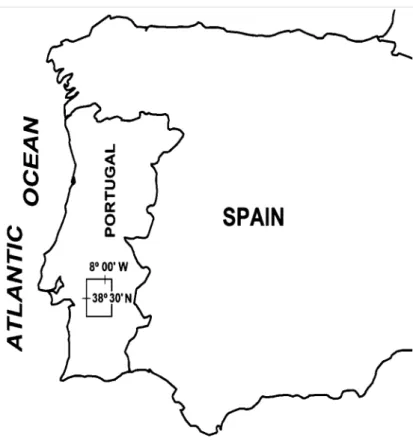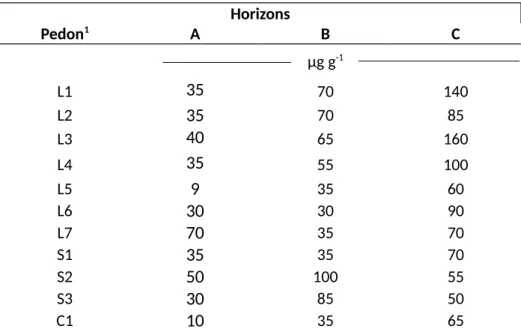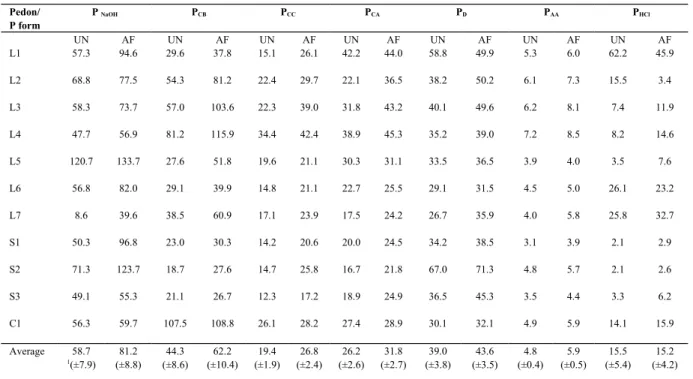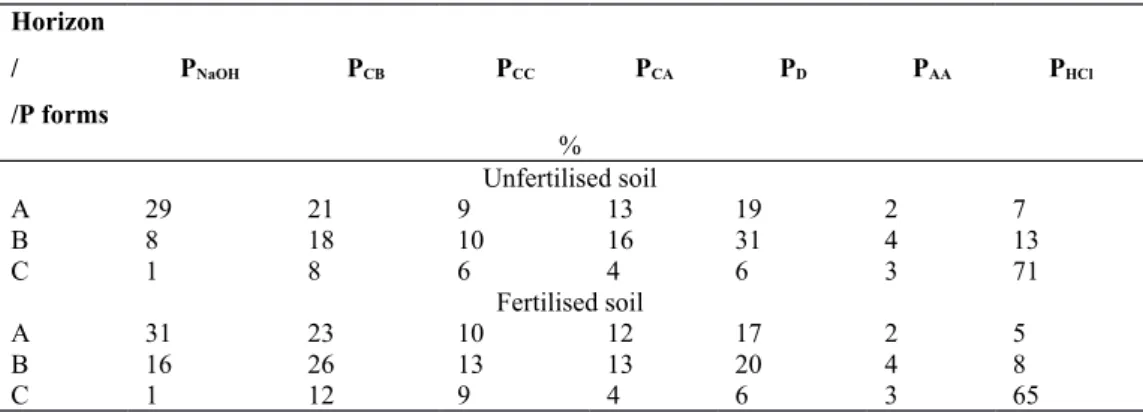Profile data of eleven pedons developed on mafic rocks in southern
Portugal
Horta, Carmo
a,b*, Monteiro, Fernando
c, Madeira, Manuel
cand Torrent, José
daInstituto Politécnico de Castelo Branco, Departamento de Ciências da Vida e dos
Alimentos, Escola Superior Agrária, Quinta da Sra. de Mércules, 6001-909 Castelo Branco, Portugal; bCERNAS, Research Centre for Natural Resources, Environment and
Society, Quinta da Sra. de Mércules, 6001-909 Castelo Branco, Portugal. cForest
Research Centre, School of Agriculture, University of Lisbon, Tapada da Ajuda, 1349-017, Lisboa, Portugal. dDepartamento de Agronomía, Universidad de Córdoba,
Edificio C4, Campus de Rabanales, 14071 Córdoba, Spain.
*Corresponding author. E-mail: carmoh@ipcb.pt
Materials and methods
Study pedons were chosen by identifying soil map units where soils are developed mostly on mafic rocks, and show increasing contents of extractable P by the ammonium lactate test with depth. As the topography of the study area is gently undulating, pedons were observed both in the upper and in the lower part of slopes. Morphology of soil profiles was described following the Guidelines for Soil Description (FAO, 2006). Identified horizons were sampled by the standard methodology.
Setting and soils
Figure S1. Page 2 Table S1. Page 3
Description of three pedons representative of the Reference Soil Groups included in the study
Materials and methods
Fertilisation experiment
Table S2. Page 7
Results and discussion
Basic soil properties
Table S3. Page 8
Phosphorus forms
Table S4. Page 9 Table S5. Page 10 Table S6. Page 11
Table S7. Page 12
Phosphorus fertiliser use
Soil P tests
Table S8. Page 13
Materials and methods
Setting and soils
Figure S1. Geographical location of the study area.
Table S1. Soil parent material and classification of study soils using the World Reference Base Classification System (IUSS, 2015) and Soil Taxonomy (Soil Survey Staff, 2014).
Soils Parent material WRB 2015 ST 2014
L1 Quartzdiorite Haplic Luvisol (Abruptic and Endosodic) Inceptic Haploxeralf
L2 Gabbro Vertic Luvisol (Sodic) Vertic Haploxeralf
L3 Gabbro Haplic Luvisol (Sodic) Inceptic Haploxeralf
L4 Gabbro Haplic Luvisol (Sodic) Inceptic Haploxeralf
L5 Gabbrodiorite Haplic Luvisol (Abruptic, Sodic) Typic Haploxeralf
L6 Gabbrodiorite Haplic Luvisol (Abruptic, Sodic) Typic Haploxeralf
L7 Metagabbro Haplic Luvisol (Sodic) Typic Haploxeralf
S1 Metagabbro Stagnic Solonetz (Abruptic, Magnesic) Typic Natraqualf S2 Gabbroic rock Stagnic Solonetz (Albic, Magnesic) Typic Natrixeralf S3 Metagabbro Stagnic Solonetz (Abruptic, Magnesic) Typic Natraqualf
C1 Gabbrodiorite Haplic Cambisol (Sodic) Typic Haploxerept
Description of three pedons representative of the Reference Soil Groups included in the study
Pedon L1:
Classification: Haplic Luvisol (Abruptic and Endosodic) (WRB 2014); Inceptic Haploxeralf (Soil Taxonomy 2014).
Location: 38° 45’ 22,6’’N; 7° 51’ 18,7’’W Lithology: quartzdiorite
Landform and topography: level land; observation pit located in the higher part of a very gentle slope (1-2% slope angle)
External drainage: moderately well to well drained Permeability: low
Land use: cropland Vegetation: oats
Erosion hazard: very slight
Ap1 (000-015 cm)
Brown to pale brown, 10YR 5-6/3; very dark brown to dark brown, 10YR 3/2-3 (m); sandy loam; very few fine and medium angular quartz gravel; apedal or with weak fine granular structure around the roots; soft consistence; few fine interstitial voids; common to many fine and very fine roots. Diffuse and smooth boundary.
Ap2 (015-032 cm)
Brown to pale brown, 10YR 5-6/3; dark brown, 10YR 3/3 (m); loamy sand to sandy loam; very few medium and coarse subangular quartz gravel; apedal; soft to slightly hard consistence; few fine interstitial voids; few to very few fine and very fine roots. Abrupt and smooth boundary.
Bt (032-062 cm)
Yellowish brown, 10YR 5/4; Brown to dark brown, 10YR 3-4/3 (m); clay loam; moderated angular blocky medium structure; few fine vertical and polygonal cracks; very hard consistence; almost without voids; very few very fine roots. Gradual and smooth boundary.
Quartzdiorite rock in varying degrees of weathering with blackish and yellowish colours, coexisting with soil material similar to that of the Bt horizon; hard; very few very fine roots; almost dry. Gradual boundary.
C1 (105-155 cm)
Weathered quartzdiorite rock with low coherence; slightly moist. Diffuse boundary.
C2 (155-200+ cm)
Pedon S1:
Classification: Stagnic Solonetz (Abruptic, Magnesic) (WRB 2014); Typic Natraqualf (Soil Taxonomy 2014).
Location: 38° 19’ 56,4’‘N; 08° 02’ 22,1’’W Lithology: metagabbro
Landform and topography: level land; observation pit located in a slight depression, in the bottom of a nearly level slope (0.2-0.5% slope angle)
External drainage: poorly drained Permeability: very low
Land use: cropland
Vegetation: wheat, after a four-year fallow Erosion hazard: none
Ap1 (000-017 cm)
Pale brown, 10YR 6/3; brown to dark brown, YR 4-5/3 (m); sandy loam; few Fe and Mn concretions; very few fine quartz gravel; apedal; soft consistence; few to common fine interstitial voids; common to many medium roots and very few fine ones. Gradual and smooth boundary.
Ap2 (015-035 cm)
Pale brown, 10YR 6/3; brown to dark brown, 10 YR 4/3 (m); many distinct yellowish mottles; sandy loam; common Fe and Mn concretions of fine gravel size; very few medium quartz gravel; apedal; slightly hard to hard consistence; few fine interstitial voids; few to very few fine roots. Abrupt and smooth boundary.
Btn1 (035-070 cm)
Grayish brown to brown, 10 YR 5-2/3; dark grayish brown, 10 YR 4/2 (m); clay loam; very few quartz coarse gravel and common fine gravel sized Fe and Mn concretions, namely in the upper part of the horizon; strong coarse prismatic structure breaking to angular blocky coarse peds; slickensides on the face of peds; few to common fine and medium vertical cracks; very hard consistence; almost without voids; very few fine roots. Clear and smooth boundary.
Btn2 (070-095 cm)
Pale brown to light yellowish brown, 10 YR 6/3-4; yellowish brown 10 YR 5/4 (m); sandy clay loam; very few fine gravel of feldspar minerals; strong medium angular blocky structure; few fine vertical cracks; very hard consistence; almost without voids; without roots. Clear and smooth boundary.
Cn1 (095-116 cm)
Weathered metagabbro with rock structure; hard to very hard; without roots; almost dry. Gradual boundary.
Cn2 (116-180 cm)
Weathered metagabbro with high coherence; slightly moist. Diffuse boundary.
CR (180-220+ cm)
Pedon C1:
Classification: Haplic Cambisol (Sodic) (WRB 2014); Typic Haploxerept (Soil Taxonomy 2014).
Location: 38° 32’ 26,7’’N; 07° 49’ 13,2’’W Lithology: gabbrodiorite
Landform and topography: level land; observation pit located near the summit of a nearly level slope (0.2-0.5% slope angle)
External drainage: well drained Permeability: moderate
Land use: crop land Vegetation: beet Erosion hazard: slight
Ap1 (000-010 cm)
Brown to dark brown, 10YR 4/3; very dark grayish brown, 10YR 3/2 (m); sandy clay loam; very few medium gravel of rock and quartz; moderate fine and medium subangular blocky structure; slightly hard consistence; few fine voids; very few fine, medium and coarse roots. Gradual and smooth boundary.
BA (010-025 cm)
Dark yellowish brown, 10YR 4/4; dark brown, 10YR 3/3 (m); sandy clay loam; very few fine and medium gravel of quartz and feldspars; weak medium angular blocky structure; very few fine vertical cracks; hard consistence; few fine and medium voids; very few fine roots. Clear and smooth boundary.
Bw (025-042 cm)
Yellowish brown, 10YR 5/4; brown to dark brown, 10YR 3-4/3 (m); sandy clay loam; few coarse quartz gravel and very few fine gravel of feldspar minerals; weak angular blocky medium peds organized in weak medium prismatic peds; very few fine vertical cracks; hard and very hard consistence; almost without voids; very few fine roots. Gradual and wavy boundary.
B/C (042-060 cm)
Yellowish brown, 10YR 5/5; dark yellowish brown, 10YR 3/4 (m); sandy clay loam to sandy loam; few fine gravel of feldspar minerals; moderate medium prismatic structure; few fine vertical cracks; very hard consistence; without voids; very few fine roots. There are small inclusions of less weathered rock material, similar to that of the underlying layer. Clear and wavy boundary.
C/B (060-085 cm)
Weathered gabbrodioritic rock with brownish and grayish colours, coexisting with inclusions of loamy sand soil material with yellowish brown colour, 10YR 5/6; slightly hard to hard; very few very fine roots. Diffuse and wavy boundary.
C1 (085-140 cm)
Very weathered and arenized gabbrodiorite, with yellowish red and light brown colours; moderate cohesion; without roots; almost dry. Diffuse and wavy boundary.
C2 (140-210+ cm)
Materials and methods
Fertilisation experiment
Table S2. Amount of P (µg g-1) added to each soil sample to reach 0.5 – 0.6 mg P L-1 in the soil
solution. Horizons Pedon1 A B C µg g-1 L1 35 70 140 L2 35 70 85 L3 40 65 160 L4 35 55 100 L5 9 35 60 L6 30 30 90 L7 70 35 70 S1 35 35 70 S2 50 100 55 S3 30 85 50 C1 10 35 65
Results and discussion
Basic soil properties
Table S3. Mean values of soil properties in the different horizons of study soils.
Horizon/ /properties Clay CM1 BD2 SB3 pH Feox3 FeD4 Alox3 AlD4 g kg-1 g cm-3 cmol c kg-1 g kg-1 A 158.64 b K,V 1.52 b 9.10 b 6.27 c 0.87 a 3.86 b 0.40 b 0.77 b B 344.64 a LCV,V,K 1.78 a 19.24 a 7.09 b 0.68 b 6.18 a 0.61 a 1.26 a C 140.18 b V,LCV 1.86 a 17.99 a 8.13 a 0.23 c 4.24 b 0.29 c 0.70 b
1– Clay mineralogy (K – Kaolinite, V – Vermiculite, LCV – Low charge vermiculite); 2– Bulk density (BD); 3Sum of
exchangeable bases: SB = (Ca2++Mg2++Na++K+); 3–acid oxalate-extractable Fe and Al; 4–citrate/bicarbonate/dithionite-extractable Fe and Al; Different letters in the same column means significant
Results and discussion
Phosphorus forms
Table S4. Forms of P (mg P kg-1) in unfertilised (UN) and fertilised (AF) samples of the
A horizon of each pedon
Pedon/ P form P NaOH PCB PCC PCA PD PAA PHCl UN AF UN AF UN AF UN AF UN AF UN AF UN AF L1 57.3 94.6 29.6 37.8 15.1 26.1 42.2 44.0 58.8 49.9 5.3 6.0 62.2 45.9 L2 68.8 77.5 54.3 81.2 22.4 29.7 22.1 36.5 38.2 50.2 6.1 7.3 15.5 3.4 L3 58.3 73.7 57.0 103.6 22.3 39.0 31.8 43.2 40.1 49.6 6.2 8.1 7.4 11.9 L4 47.7 56.9 81.2 115.9 34.4 42.4 38.9 45.3 35.2 39.0 7.2 8.5 8.2 14.6 L5 120.7 133.7 27.6 51.8 19.6 21.1 30.3 31.1 33.5 36.5 3.9 4.0 3.5 7.6 L6 56.8 82.0 29.1 39.9 14.8 21.1 22.7 25.5 29.1 31.5 4.5 5.0 26.1 23.2 L7 8.6 39.6 38.5 60.9 17.1 23.9 17.5 24.2 26.7 35.9 4.0 5.8 25.8 32.7 S1 50.3 96.8 23.0 30.3 14.2 20.6 20.0 24.5 34.2 38.5 3.1 3.9 2.1 2.9 S2 71.3 123.7 18.7 27.6 14.7 25.8 16.7 21.8 67.0 71.3 4.8 5.7 2.1 2.6 S3 49.1 55.3 21.1 26.7 12.3 17.2 18.9 24.9 36.5 45.3 3.5 4.4 3.3 6.2 C1 56.3 59.7 107.5 108.8 26.1 28.2 27.4 28.9 30.1 32.1 4.9 5.9 14.1 15.9 Average 58.7 1(±7.9) 81.2 (±8.8) 44.3 (±8.6) 62.2 (±10.4) 19.4 (±1.9) 26.8 (±2.4) 26.2 (±2.6) 31.8 (±2.7) 39.0 (±3.8) 43.6 (±3.5) 4.8 (±0.4) 5.9 (±0.5) 15.5 (±5.4) 15.2 (±4.2)
1(±standard error, n = 11); 2-Subscript: NaOH – NaOH 0.1 M + NaCl 1 M – extractable; CB – sodium citrate 0.267 M + sodium bicarbonate 0.111 M – extractable; CC – sodium citrate 0.2 M + citric acid 0.2 M at pH 6.0 – extractable; CA – sodium citrate 0.2 M +
ascorbic acid at pH 6.0 – extractable; D – citrate / bicarbonate / dithionite – extractable; AA – acetic acid 1 M + sodium acetate at pH 4.0 – extractable; HCl – HCl 1 M – extractable.
Table S5. Forms of P (mg P kg-1) in unfertilised (UN) and fertilised (AF) samples of the
B horizon of each pedon
Pedon/ P form P NaOH PCB PCC PCA PD PAA PHCl UN AF UN AF UN AF UN AF UN AF UN AF UN AF L1 5.1 29.4 22.4 61.4 9.8 23.5 42.2 57.9 94.1 98.3 9.6 11.6 54.5 59.7 L2 6.7 23.0 17.2 72.5 11.7 23.9 16.6 24.6 31.0 38.2 4.5 6.6 2.2 3.1 L3 5.9 16.1 28.8 76.6 11.7 29.2 17.6 28.1 36.7 40.1 5.5 9.6 29.0 37.4 L4 4.9 14.2 29.8 73.7 13.0 32.8 18.6 25.2 26.6 30.7 4.9 7.1 15.8 18.2 L5 0.8 12.9 13.9 34.4 8.5 16.6 9.7 11.4 19.5 21.9 3.3 3.6 6.9 7.3 L6 2.7 34.5 13.7 32.3 9.0 31.7 12.0 20.6 25.4 27.4 4.0 22.7 27.3 28.3 L7 39.2 75.0 24.5 29.9 13.2 18.6 19.5 27.0 35.6 38.7 3.5 4.5 3.4 5.6 S1 3.5 22.1 13.9 31.6 9.6 15.9 10.6 14.8 20.4 32.9 2.7 4.8 6.8 8.0 S2 5.3 61.1 11.1 37.6 8.1 23.2 17.3 31.5 37.6 47.9 6.4 7.4 2.0 2.9 S3 2.2 18.0 14.1 61.7 8.9 25.9 12.1 24.1 33.9 38.9 4.1 5.7 6.2 8.9 C1 33.8 32.5 33.0 50.1 13.7 21.5 21.4 25.9 28.3 32.0 4.9 5.8 20.9 20.6 Average 10.0 1(±4.0) 30.8 (±6.0) 20.2 (±2.4) 51.1 (±5.6) 10.7 (±0.6) 23.9 (±1.7) 17.9 (±2.7) 26.5 (±3.6) 35.4 (±6.2) 40.6 (±6.2) 4.9 (±0.6) 8.1 (±1.6) 15.9 (±4.9) 18.1 (±5.3)
1(±standard error, n = 11); Subscript: NaOH – NaOH 0.1 M + NaCl 1 M – extractable; CB – sodium citrate 0.267 M + sodium bicarbonate 0.111 M – extractable; CC – sodium citrate 0.2 M + citric acid 0.2 M at pH 6.0 – extractable; CA – sodium citrate 0.2 M +
ascorbic acid at pH 6.0 – extractable; D – citrate / bicarbonate / dithionite – extractable; AA – acetic acid 1 M + sodium acetate at pH
Table S6. Forms of P (mg P kg-1) in unfertilised (UN) and fertilised (AF) samples of the
C horizon of each pedon
Pedon/ P form P NaOH PCB Pcc PCA PD PAA PHCl UN AF UN AF UN AF UN AF UN AF UN AF UN AF L1 9.8 6.5 89.9 141.9 40.1 49.5 35.1 37.2 45.8 48.1 36.5 33.5 804.9 1226.5 L2 1.2 2.4 36.2 52.8 31.6 63.8 14.6 24.3 22.5 24.3 5.4 4.8 23.5 11.8 L3 4.4 8.8 83.7 146.4 43.9 61.5 37.4 46.2 42.3 51.7 25.1 30.3 424.9 442.8 L4 2.9 4.6 58.9 97.3 26.0 34.5 20.0 23.6 22.9 25.1 11.0 12.0 161.5 139.3 L5 4.9 8.9 27.1 39.4 30.3 45.6 13.9 17.8 22.3 24.9 6.1 9.7 29.5 45.1 L6 2.1 2.1 14.4 73.4 13.7 35.7 17.5 21.5 23.9 26.9 22.6 24.6 447.7 450.7 L7 3.2 4.9 29.5 44.9 27.9 45.5 17.1 21.3 37.5 46.1 10.6 11.5 498.7 488.5 S1 3.5 3.5 38.2 59.8 31.6 49.1 20.7 25.0 37.4 46.1 11.6 12.2 555.8 559.1 S2 4.2 7.6 33.8 53.7 50.8 90.6 27.2 30.8 44.3 55.1 12.6 15.2 334.7 352.9 S3 2.5 4.1 27.2 38.6 26.0 43.1 15.7 19.5 36.6 35.2 10.7 10.8 339.8 272.3 C1 6.5 7.4 33.7 50.1 28.3 35.5 24.0 25.9 29.4 31.5 30.4 28.5 363.5 353.2 Average 4.1 1(±0.7) 5.5 (±0.7) 42.9 (±7.3) 72.5 (±11.8) 31.8 (±3.0) 50.4 (±5.0) 22.1 (±2.4) 26.7 (±2.6) 33.2 (±2.8) 37.7 (±3.5) 16.6 (±3.1) 17.6 (±3.0) 362.2 (±69.4) 394.8 (±118.9)
1(±standard error, n = 11); Subscript: NaOH – NaOH 0.1 M + NaCl 1 M – extractable; CB – sodium citrate 0.267 M + sodium bicarbonate 0.111 M – extractable; CC – sodium citrate 0.2 M + citric acid 0.2 M at pH 6.0 – extractable; CA – sodium citrate 0.2 M +
ascorbic acid at pH 6.0 – extractable; D – citrate / bicarbonate / dithionite – extractable; AA – acetic acid 1 M + sodium acetate at pH
Table S7. Mean values of P forms (n=11) in A, B and C horizons (expressed as a percentage of the sum of P in all fractions) extracted according to the fractionation scheme of Ruiz et al. (1997) in unfertilised and fertilised soils.
Horizon / /P forms PNaOH PCB PCC PCA PD PAA PHCl % Unfertilised soil A 29 21 9 13 19 2 7 B 8 18 10 16 31 4 13 C 1 8 6 4 6 3 71 Fertilised soil A 31 23 10 12 17 2 5 B 16 26 13 13 20 4 8 C 1 12 9 4 6 3 65
Subscript: NaOH – NaOH 0.1M + NaCl 1M – extractable; CB – sodium citrate 0.267 M + sodium bicarbonate 0.111 M – extractable; CC – sodium citrate 0.2 M + citric acid 0.2 M at pH 6.0 – extractable; CA – sodium citrate 0.2 M + ascorbic acid at pH 6.0 – extractable; D – citrate / bicarbonate / dithionite – extractable; AA – acetic acid 1 M + sodium acetate at pH 4.0 – extractable; HCl – HCl 1 M – extractable.
Results and discussion
Phosphorus fertiliser use
Soil P tests
Table S8. Soil Test P after fertilisation (AL-P and Olsen P; mg kg-1) for A, B and C
Fertilised soil P recovery by Soil Test P AL-P mg kg-1 P rec (AL-P) Horizon/ Pedon A B C A B C L1 43 24 94 0.66 0.34 0.56 L2 62 45 123 0.89 0.60 1.40 L3 66 36 66 0.90 0.49 0.29 L4 83 45 61 1.06 0.73 0.51 L5 72 38 53 1.00 1.03 0.82 L6 46 45 45 0.67 1.43 0.39 L7 34 25 92 0.47 0.71 1.21 S1 40 26 83 0.80 0.74 0.89 S2 39 36 80 0.62 0.35 1.04 S3 33 43 45 1.03 0.51 0.78 C1 84 45 124 0.30 0.89 1.58 Average (n=11) 55 37 79 0.76 0.71 0.86 Olsen P mg kg-1 P rec (Olsen P) Horizon/ Pedon A B C A B C L1 28 16 14 0.43 0.23 0.10 L2 37 26 57 0.06 0.37 0.67 L3 43 20 20 0.28 0.26 0.09 L4 52 23 8 0.17 0.31 0.08 L5 71 15 10 0.44 0.37 0.05 L6 36 7 7 0.10 0.23 0.08 L7 19 17 8 0.16 0.46 0.11 S1 22 13 29 0.43 0.29 0.41 S2 21 19 13 0.32 0.19 0.23 S3 19 23 7 0.17 0.27 0.08 C1 82 30 60 0.20 0.63 0.92 Average (n=11) 39 19 21 0.25 0.33 0.26






